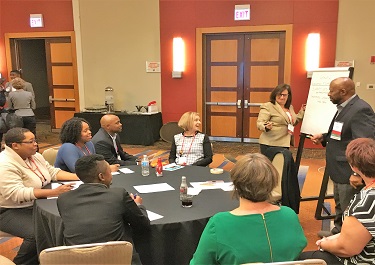 There is no getting around it. Our life experiences and personal connections cause each of us to see, interact and listen to some with less objectivity than others. We can’t help it. Our brains are wired that way, to treat people who don’t speak or look like those we’ve associated differently. The term experts use to describe that situation is unconscious bias ‒ and we all have it.
There is no getting around it. Our life experiences and personal connections cause each of us to see, interact and listen to some with less objectivity than others. We can’t help it. Our brains are wired that way, to treat people who don’t speak or look like those we’ve associated differently. The term experts use to describe that situation is unconscious bias ‒ and we all have it.
At least to some degree, according to Tyi McCray, Ph.D., Diversity & Inclusion Partner at Forshay. She recently shared her expertise on unconscious bias in a webinar hosted by our CompTIA Advancing Diversity in Technology Community ‒ what an enlightening presentation!
She started off defining unconscious bias for the audience. “We all filter information through our own lens. It’s how we listen and make decisions. We filter information based on our past experiences, education, family & friends, and cultural norms.” McCray emphasized that unconscious bias looks different for everyone.
Test Yourself
Seeing is believing. Whether it’s hubris or humility, few of us readily admit our biases. What many fail to understand is that our brains receive 11 million pieces of information at any moment in time, and can only consciously process around 40 of those things. So, it looks for patterns based on past experiences and fills in the gaps.
In our webinar, McCray asked the audience to think of the five people closest to them; usually family, friends or co-workers. Those personal relationships influence how you filter the world. The brain’s automatic tendency is to take mental shortcuts (which can include cultural stereotypes) to subconsciously and quickly process information is affected by those around you every day.
Why is that a bad thing? As McCray points out, it can affect employment screening, interviewing, hiring and even retention processes in the workplace. “If I ask you to imagine a leader, a CEO, or a doctor, what would they look like to you? Our brain automatically associates certain identifiers that can affect our decisions when interviewing and hiring.”
Unconscious bias in the tech industry is a real concern. Based on results of those who have taken the implicit association test, 70% or participants are faster to associate men with science than women (go to implicit.harvard.edu and take the test yourself). Results were the same for men and women ‒ even women scientists!
What Can We Do About it?
Once we understand how our brains filter information, we can take steps to control it, McCray suggests. “You can develop a strategy to manage unconscious bias and then employ tools that help you make better decisions.”
A great starting point is in the job application process. One research study on unconscious bias looked at resumes that were identical with one exception: they changed the names at the top of the page. “When they used a ‘typical’ African American sounding name like Jamal or Lakisha, the person received 50% fewer callbacks than those with Caucasian-sounding names like Emily,” points out McCray. The name listed on the top of a resume can trigger unconscious bias.
She emphasized that researchers replicated those studies in other countries and the results were similar but involved different cultures. It worked the same way when they tested by gender, socio-economic status, and abilities. Researchers found that just a small piece of information on an application or resume can cause unconscious bias, including the applicant’s address, schools, and memberships in certain organizations.
Employers need a strategy for overcoming those innate preconceptions. McCray suggests they start by developing a checklist list of essential qualifications for the resume review process.
- Use blind resume reviews without names or addresses
- Determine questions and create grading criteria for evaluation BEFORE you begin interviewing
- Define each value you are assessing for and use structure in your assessment. Be as careful and precise in evaluation for culture fit as you are in technical skills.
Those are just the first steps. Companies should develop processes and strategies for managing unconscious bias in all aspects of the operations. That means assessing the criteria used in training and for performance assessments and advancements, and for developing work teams and objectives.
Unconscious bias can undermine a company’s morale and its collaborative efforts, and bring a host of related issues to the forefront. Recognition is the first step in solving the problems, followed by a strategy that helps team members understand how to deal more effectively with their own perceptions. If it works, everyone should be a lot happier (and more productive).
Aaron Woods is the Director of Strategic Partner Programs at Xerox Corp and Vice-Chair of the CompTIA Advancing Diversity in Technology Community

